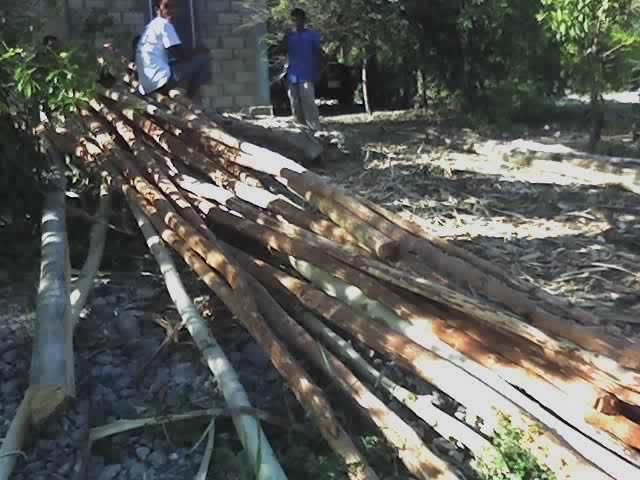But I don't have any photos of us peeling. What I have photos of is the beams and posts being peeled.
When building tasiste houses, beams are normally peeled. This gives a neater appearance, and eliminates cleaning up after bits of bark flaking off over the years.
Posts and palmetto sticks used as wall are not normally peeled as best practice is to plaster the walls both inside and out. We intend to plaster everywhere outside the house, but inside the house we are thinking to only plaster the walls and not the posts. The posts are really attractive and it seems a shame to cover them in plaster. I had wanted to leave them unplastered on the outside of the house too, but it was suggested that they should be plastered outside otherwise they would not last so long.
Today, there was a great peeling party and all the peeling of all the beams and the posts we intend to use for the house was completed.

That is Mr. Canul, and Roni finishing up the peeling of the posts.
I am disappointed with these pictures. They do not well represent the true colors and beauty of the wood.

These are the peeled beams. The reddish ones that are mostly visible in this picture are of a tree called bob. Despite my efforts I am unable to identify this tree to genus, though I can recognize it in the field. It is pronounced with a long o. I have asked how to spell it, and this yields a puzzled stare and the answer, bob. Internet searches for the identity of the bob tree or boob tree have yielded very disquieting results. It is a tree that grows fairly fast, straight and tall. It is often used for beams as it is strong, but it is not used for posts, as it would rot in the ground. It is considered hard to peel.
The whitish beams, not so visible are of a tree called negrito. I asked why a tree with white wood would be called negrito which indicates the color black. It was explained that this wood turns black wherever it is exposed to rain. This tree is Simaruba glauca and it is often used for beams as it is strong and generally straight. It is not used for posts as it would rot in the ground. It is considered easy to peel.

Here are some of the posts.
Most of these are Madre Cacao or Gliricidia sepium. This is a fast often straight growing tree. Considered very strong, it is one of the species sought for posts as it is resistant to termites and rot.
One of the posts is of the tinta tree or logwood tree or Haematoxylum campechianum. The tinta tree is often used for posts as it is rot and termite resistant. It is also the source of a red, purple, and black dye. It is an important tree in the history of Belize as without this tree, Belize would never have existed.
A black and a white logwood cutter are depicted in the national emblem of Belize, which appears on the Belize flag and on Belize currency.
We will find a special place to put the tinta post.
No comments:
Post a Comment